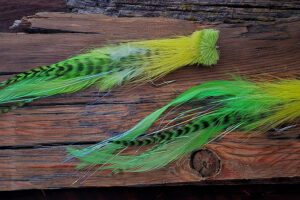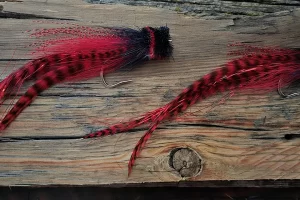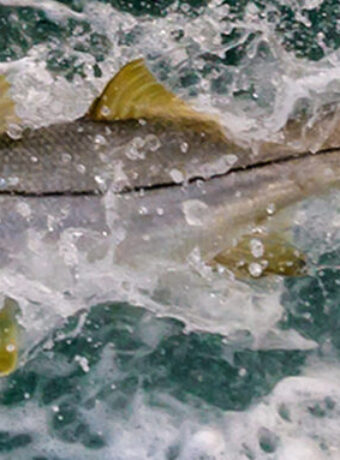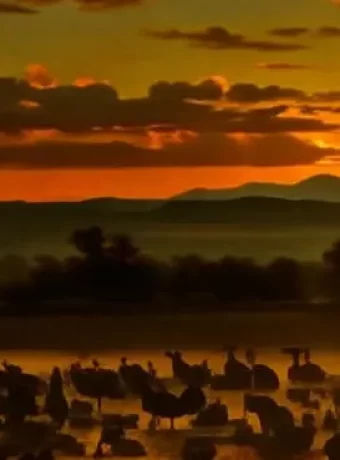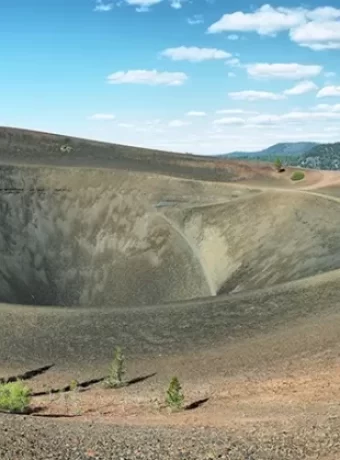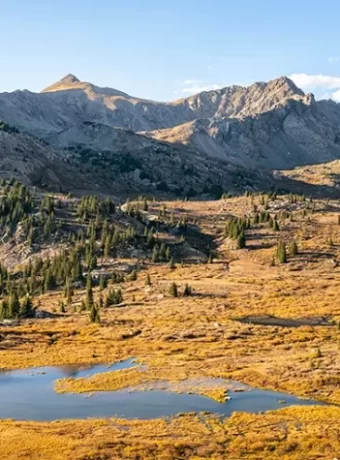Top Places to Fly Fish Kentucky – And What Flies to Use
Kentucky, with its diverse waters, is a fly fisher’s dream. This guide explores the top places to fly fish Kentucky and suggests effective flies. Whether you’re pursuing trout in a cool mountain stream or bass in a sprawling lake, the Bluegrass State offers a spot for every angler.
We’ll cover well-stocked streams and hidden gems, focusing on productive fly fishing locations. I’ll also share fly recommendations based on my fishing experience in these waters. So, if you’ve ever wanted to experience the magic that the Bluegrass state has to offer, this guide is for you. So Go Fly Fish Kentucky!
Table of Contents
Top Places to Fly Fish Kentucky Streams and Creeks
Hatchery Creek: Located in the Daniel Boone National Forest, Hatchery Creek is known for its consistent trout fishing. Regularly stocked with trout averaging 8–12 inches (and potential for larger “holdovers”), it’s ideal for anglers of all skill levels, especially during fall and spring.
More information about Hatchery Creek is available at the Kentucky Department of Fish & Wildlife and pick up a Fishing License Online.
Rock Creek: A Blue Ribbon trout stream and Kentucky Wild River, Rock Creek is more remote. It rewards patient anglers with beautiful scenery, wildlife sightings, and rainbow trout often exceeding 12 inches, thanks to lower fishing pressure.
Fly Fishing Kentucky having quality performance outdoor apparel can make or break a trip. A great outer layer is our Hydrophobic Magic Waters Graphic Hoodie.
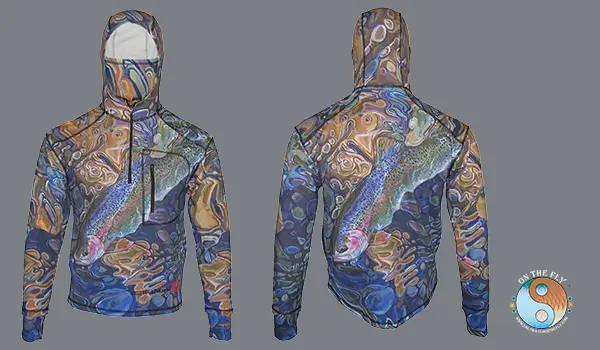
Rock Creek Fly Fishing
Rock Creek, tucked away in the Daniel Boone National Forest, is a fly fisherman’s dream. This Kentucky gem is famous for its brook trout and smallmouth bass. But the creek offers more than just fish. The surrounding forest creates a peaceful setting. This makes a perfect backdrop for a day on the water.
The cool, clear water of Rock Creek makes it a great spot for wading. You can cast your line into the many pools and riffles. This creek is perfect for both beginners and seasoned anglers. This is because it offers a variety of challenges.
When fly fishing Rock Creek, consider these flies:
- Parachute Adams: This fly mimics a variety of insects. This makes it a versatile choice for attracting both brook trout and smallmouth bass.
- Gold-Ribbed Hare’s Ear: This nymph is a classic pattern. It imitates aquatic insects. These are a primary food source for trout. It also works well for smallmouth bass.
The best time to fish Rock Creek is during the spring and fall. The weather is milder. The water temperatures are ideal for trout and bass. But summer fishing can also be productive. Especially during the early morning and late evening hours when the water is cooler.
Beyond fishing, Rock Creek offers opportunities for hiking and exploring the Daniel Boone National Forest. So, pack a lunch, bring your hiking boots, and make a day of it. This is what makes Rock Creek a top fly fish Kentucky destination.
East Fork Indian Creek: Located in the Red River Gorge, this creek features stunning natural beauty, clear waters, and diverse trout populations. The creek bed is rocky with deep sections, so sturdy shoes and waders are recommended. For more fishing location options, be sure to explore Kentucky Fish and Wildlife’s list of stocked trout waters.
Parched Corn Creek: Nestled in the Red River Gorge Wilderness Area (Daniel Boone National Forest), this stocked brook trout stream is a hidden fly fish Kentucky gem.
Parched Corn Creek Fly Fishing
Parched Corn Creek, tucked away in Daniel Boone National Forest, offers a different fly fishing experience than the bigger Kentucky rivers. This small stream meanders through the forest. It creates a quiet, intimate setting for the fly fisher. The creek’s clear, cool water holds a healthy population of rainbow trout. But there are also some brown trout if you know where to look. On a fly fish Kentucky trip I fished Parched Corn Creek, just because I liked the name I used my 1-weight. A great time.
This creek is perfect for those who like a good hike with their fishing. The access points require a bit of a walk. This keeps the crowds away. You’ll feel like you have the whole stream to yourself. This makes it great for a peaceful day in nature.
The best way to fish Parched Corn Creek is to wade upstream. This helps you to approach the trout without spooking them. Because the creek is small, a shorter fly rod is best. Something around 6 to 7 feet will give you good control. This is especially true in the tight spaces under the trees.
For flies, think small and natural. The trout in Parched Corn Creek are picky. They’re used to seeing bugs drift naturally downstream. So, match the hatch if you can. A few good choices include:
- Dry Flies: Parachute Adams, Elk Hair Caddis, Blue Wing Olive
- Nymphs: Pheasant Tail, Hare’s Ear, Prince Nymph
- Streamers: Wooly Bugger (small, olive or black), Muddler Minnow
Because the water is clear, use a light tippet. This will help your flies drift naturally. It also makes them harder for the trout to see. Also, don’t be afraid to experiment with different retrieves. Sometimes a slow, steady retrieve works. But other times, a little twitch or pause can entice a strike.
Parched Corn Creek may not offer the big fish of Kentucky’s larger waters. But it provides a special kind of fly fishing experience. It’s about the quiet beauty of the forest. It’s about the challenge of tricking wary trout in a small stream. This creek is perfect for anyone looking for a more intimate connection with nature.

Text content
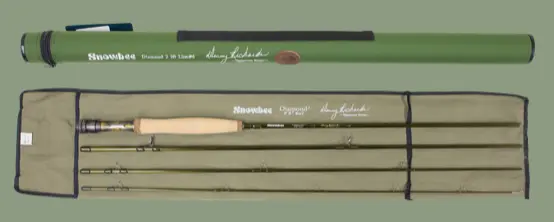
Text content
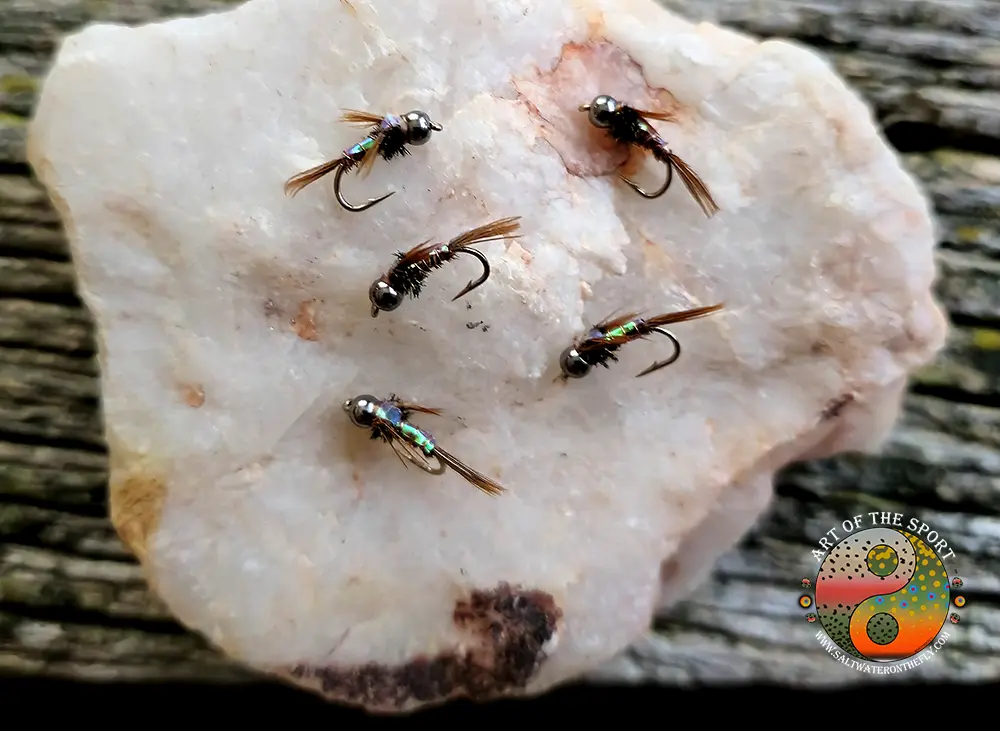
Goose Creek Fly Fishing
Goose Creek, tucked away in the Daniel Boone National Forest, offers some fantastic fly fishing. This creek is a hidden gem for those who love to chase smallmouth bass. It’s also a great spot for panfish, and you might even hook a rock bass or two.
The scenery along Goose Creek is just beautiful. The clear water flows through a lush forest, making for a peaceful and enjoyable fishing experience. You can wade in the creek or fish from the bank. This makes it a good choice for anglers of all skill levels.
What flies should you use on Goose Creek? Well, smallmouth bass in this creek love Clouser Minnows. A size 4 or 6 should do the trick. Olive and white are good color choices. Poppers can also be effective, especially during the warmer months. Try a size 6 or 8 popper in a yellow or black color. If you’re targeting panfish, try a size 10 or 12 nymph. A Prince Nymph or a Pheasant Tail Nymph will often entice a bite.
Goose Creek has some special regulations, so it’s important to check those before you go. Because it’s in the Daniel Boone National Forest, there might be some specific rules about access or fishing methods. Always good to be prepared and know what’s allowed while you fly fish Kentucky.
Getting to Goose Creek is part of the adventure. Some sections are easy to reach. Others require a bit of a hike. This adds to the secluded feel. This makes it even more rewarding when you find that perfect fly fishing spot. Just be sure to wear sturdy shoes and bring plenty of water, especially if you plan on hiking to a more remote location.
Goose Creek is a great option if you want a fly fish Kentucky experience that’s a little off the beaten path. It’s a place where you can enjoy the beauty of nature and the thrill of catching some nice fish. Just remember to pack the right flies, check the regulations, and get ready for a memorable Kentucky fly fishing trip.
Laurel Creek Fly Fishing
Laurel Creek, tucked away in the Daniel Boone National Forest, is a hidden gem for fly fishermen. This stream offers beautiful scenery and great fishing. It’s a tributary of the Cumberland River, adding to its allure. This creek is known for its wild brown trout. These fish provide a thrilling challenge for any angler.
Although smaller than some Kentucky rivers, Laurel Creek has a lot to offer. Its size makes it perfect for wading. The creek winds through forested areas. This provides shade and cover for the trout. The cool, clear water makes it an ideal trout habitat. This helps keep those brown trout happy and healthy.
When it comes to fly fishing Laurel Creek, a few key flies work well. Because this is a smaller creek, smaller flies are generally better. Think sizes 14-18. Light-colored dry flies can be effective. A Parachute Adams or Elk Hair Caddis can entice those trout to the surface, especially during a hatch. If the fish aren’t rising, try nymphing. Pheasant Tail nymphs and Hare’s Ear nymphs are good choices. Small streamers, like a Wooly Bugger, can also be effective. But remember to match the size of your fly to the size of the insects in the creek. This will increase your chances of a successful catch.
Laurel Creek is a special place for fly fish Kentucky. Its wild brown trout, clear waters, and beautiful surroundings make it a must-visit. So grab your fly rod, pack your waders, and get ready for an unforgettable Kentucky fly fishing adventure.
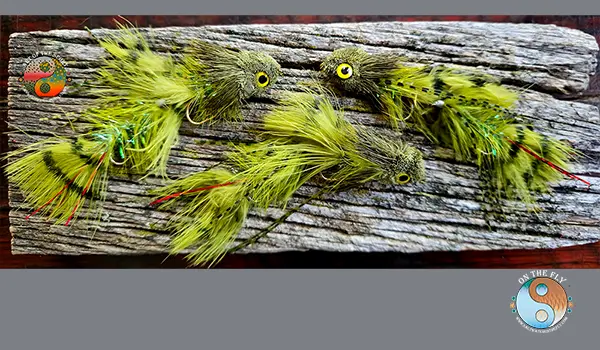
Swift Camp Creek Fly Fishing
Swift Camp Creek, tucked away in the Daniel Boone National Forest, offers some top-notch fly fishing in Kentucky. This creek holds a special place for those who love chasing trout. It’s a spot where you can truly get lost in nature.
This creek is well-known as a prized spot for wild brook trout. Although other trout species aren’t stocked here, the brook trout fishing is excellent. The creek’s cool, clear water creates the perfect home for these beauties. It’s a great place to test your fly fishing skills.
What flies should you use in Swift Camp Creek? Smaller dry flies often work wonders. Think Parachute Adams, Elk Hair Caddis, or even a simple Griffith’s Gnat. These flies mimic the insects that naturally occur in the area. This makes them tempting snacks for hungry trout. If dry flies aren’t producing, try a small nymph like a Pheasant Tail or a Hare’s Ear. These can be fished under an indicator or dead-drifted through deeper pools. This can be especially effective during colder months or when the trout are being picky.
Because Swift Camp Creek is in the Daniel Boone National Forest, access can be a bit tricky. Some hiking may be involved to reach the best fishing spots. But the peace and quiet you’ll find are worth the effort. Just imagine yourself standing in a crystal-clear stream, surrounded by towering trees, with a fly rod in your hand. This is what Swift Camp Creek offers. It’s a true escape from the everyday hustle. This makes it a perfect spot for a fly fishing adventure in Kentucky.
While you’re in the area, consider exploring other nearby places. Rock Creek, also in the Daniel Boone National Forest, is known for its brook trout and smallmouth bass. The Cumberland River, flowing through Cumberland Falls State Resort Park, offers rainbow and brown trout, plus smallmouth bass. Both are great options for expanding your Kentucky fly fishing experience.
Floyds Fork Fly Fishing
Floyds Fork is a beautiful stream that winds through Kentucky’s horse country. It offers amazing fly fishing for smallmouth bass. The clear water makes for some exciting sight fishing. You can often see the bass hiding among the rocks and submerged logs.
This is a great spot for both beginners and experienced fly fishers. The wading is fairly easy, but watch out for slick rocks. The slower pools are perfect for practicing your casting. More experienced anglers will enjoy the challenge of targeting the bigger bass in the faster runs.
What flies should you use on Floyds Fork? Here are a few suggestions:
- Clouser Minnows: These streamers imitate minnows, a favorite snack for smallmouth. Use a slow retrieve to entice the bass.
- Wooly Buggers: Another great streamer choice. These flies can be fished at different depths. They’re also good for catching other fish in the stream.
- Poppers: On warm summer days, try a popper. The surface disturbance can draw some explosive strikes from the bass. This is especially fun in the early morning or evening.
- Crayfish patterns: Smallmouth bass love crayfish. Try a crayfish imitation bounced along the bottom of the stream.
Floyds Fork offers a peaceful and scenic fly fishing experience. This is a nice change of pace from some of Kentucky’s busier fishing spots. The abundant wildlife and clear water make this a truly special place to cast a line.
Otter Creek Fly Fishing
Otter Creek is a jewel for fly fishers in Kentucky. This gorgeous stream holds a good number of brown, rainbow, and brook trout. It’s also home to smallmouth bass and other species. The creek flows through the beautiful Red River Gorge, a stunning area with cliffs, forests, and natural arches. This makes for a memorable fly fishing trip.
The further upstream you go, the more challenging the fishing gets. But don’t worry. Downstream sections are perfect for folks new to fly fishing. There’s something for every skill level. The gorge’s unique geology makes wading easy in many spots. This makes Otter Creek even better for a Kentucky fly fishing adventure.
This isn’t a big river. So, a shorter fly rod, around 7 to 8 feet, works well. This lets you cast easily in tighter spots among the trees. Because the water is often clear, a lighter tippet is a good idea. This helps your flies drift naturally. Also, be ready to change your flies. This helps you match what the fish are eating.
Think about using these flies on Otter Creek:
- Dry Flies: Elk Hair Caddis, Adams, Stimulators. These match the bugs often hatching on the water.
- Nymphs: Pheasant Tail, Prince Nymph, Hare’s Ear. These imitate the underwater insects trout love.
- Streamers: Woolly Buggers, Muddlers. These look like small fish or leeches.
Otter Creek’s trout can be picky. But they’re also willing to bite if you make smart choices. So, try different flies and see what works best on that day.
Two branches of Drakes Creek, Trammel Fork, and Middle Fork, Fly Fishing
Drakes Creek flows through central Kentucky. It offers some great spots to fly fish. Two of its branches, Trammel Fork and Middle Fork, are especially good for this. Both hold smallmouth bass and rock bass. You might also hook some panfish. But the main draw is the smallmouth.
Trammel Fork is a bit bigger than Middle Fork. This means it can handle slightly higher water levels. It also has more deep pools. These pools are great places for bass to hide. So, Trammel Fork is a good choice after a rain. Middle Fork is smaller and shallower. This makes it a better pick during lower water conditions. The clear water lets you spot the fish. This adds a fun challenge to your fly fishing.
What flies should you use on Drakes Creek? For smallmouth bass, try these:
- Clouser Minnows: These streamers look like small baitfish. Smallmouth can’t resist them.
- Woolly Buggers: This versatile fly works in lots of situations. It imitates various aquatic insects.
- Crayfish patterns: Smallmouth love crayfish. A crayfish fly is a good choice, especially near rocky areas.
For rock bass and panfish, try these smaller flies:
- Elk Hair Caddis: This fly mimics a caddisfly, a common insect on Drakes Creek.
- Parachute Adams: This dry fly works well for a variety of fish, including panfish.
- Beadhead nymphs: These nymphs sink quickly. They are good for fishing deeper pools where rock bass often hide.
Both Trammel Fork and Middle Fork offer beautiful scenery. You’ll enjoy the peaceful surroundings as you fish. Remember to check the Kentucky fishing regulations. Get a fishing license if you need one. Then get ready for some great fly fishing on Drakes Creek!
Kentucky Rivers
Cumberland River: Below Wolf Creek Dam, the Cumberland River offers excellent trout fishing year-round. Use streamers for trout below Wolf Creek Dam. Check the TVA website for release schedules.
Green River: From Mammoth Cave National Park to the Ohio River, this scenic river offers chances at various trout and bass species, even catfish. Consult the Kentucky fish species identification guide for specific patterns.
Fly recommendations depend on your target species and the river section. Above Green River Lake, trout are abundant, while the area near the Barren River confluence offers diverse panfish and bass.
Dix River: The section below Herrington Lake is regularly stocked, making it another good option for anglers fishing in central Kentucky. Try a zebra midge below a strike indicator for good results in the Dix River.
Green River Fly Fishing
Kentucky’s Green River is a fly fisherman’s dream. This gorgeous river flows through Mammoth Cave National Park. It offers amazing scenery and top-notch fishing. You’ll find plenty of smallmouth bass, panfish, and catfish. This river is also a great place to hook some musky.
The Green River is also home to some truly huge trout. It’s not uncommon to land some real trophies. But the Green River isn’t just about the fish. The surrounding area is stunning. You’ll find towering cliffs and lush forests. It’s the perfect spot for a peaceful fishing trip.
If you’re after smallmouth bass, try a Clouser Minnow. This fly imitates a crayfish. It’s a favorite snack for smallmouth. The Green River’s rocky bottom makes this fly a perfect choice. A brown or olive Woolly Bugger is also a good option.
For panfish, try a smaller fly. A size 12-16 nymph will work great. Look for areas with slower currents. These are the spots where panfish like to hang out. A soft hackle is another great fly to use.
Catfish on the Green River can be big. So you’ll need a sturdy fly rod. Try using a larger streamer. Something that imitates a baitfish will work well. A white or chartreuse Clouser Minnow is a good option.
Musky are the ultimate prize on the Green River. These fish are tough fighters. And they can grow to enormous sizes. If you’re going after musky, you’ll need specialized gear. A heavy fly rod and a strong leader are essential. For flies, try large streamers. Make sure they have some flash to attract the musky’s attention.
No matter what you’re hoping to catch, the Green River has something for you. So pack your gear, grab your fly rod, and get ready for some amazing Kentucky fly fishing.
Dix River Below Harrington Lake Fly Fishing
The Dix River tailwater below Herrington Lake is a fly fisherman’s dream. This spot is famous for its trout. Although, you can find other fish too. Smallmouth bass and panfish also call this river home. The water stays cool all year round thanks to the dam. This makes for happy trout. The scenery is beautiful, with steep wooded banks. This creates a peaceful and secluded fishing experience.
The Dix is a great place to wade. But be careful, the current can be strong. Always check the generation schedule from the dam. A wading staff can be helpful. It can help you keep your balance on those slippery rocks. You can also fish from a boat if you prefer. Float trips are a popular way to fish the Dix. They let you cover lots of water. You can also fish from the bank in many areas. Just be aware of private property.
This river offers various spots to fish. You can find long, slow pools. You can also find fast riffles and runs. This variety makes it ideal for different kinds of fishing techniques. You can try nymphing, dry fly fishing, or streamer fishing. Match your fly to the conditions and the fish you are targeting. This will give you the best chance of success.
So, what flies should you use on the Dix River? For trout, try these:
- Midges: These small flies imitate the tiny insects trout love.
- Zebra Midges: A flashy midge pattern that can attract trout in any conditions.
- Pheasant Tails: A classic nymph pattern that imitates a variety of aquatic insects.
- Hare’s Ear Nymphs: Another versatile nymph that trout find irresistible.
- Caddisflies: These flies imitate the caddisflies that hatch on the river.
- Sulphur Dries: During a hatch, a sulphur dry fly can be deadly.
If you are after smallmouth bass, try these:
- Clouser Minnows: These streamers imitate minnows and other baitfish.
- Woolly Buggers: A versatile fly that can attract both bass and trout.
- Crayfish Patterns: Bass love crayfish, so these flies can be very effective.
- Poppers: Topwater fishing for bass with a popper is exciting and productive.
The Dix River below Herrington Lake is a great place for fly fishing in Kentucky. The clear water and diverse fish population make it a must-visit for any angler. So, pack your fly rod and get ready for a great day on the water.
Kentucky Musky on the Fly
Kentucky is among the best states for musky on the fly. Musky, known as the “fish of 10,000 casts,” provides a thrilling fly fishing challenge. Taylorsville Lake, Lake Cumberland, and Dale Hollow Lake are good spots to target them.
Lake Cumberland Musky Fly Fishing
Lake Cumberland is a great place to fly fish for musky. It’s one of Kentucky’s largest lakes. This means there’s plenty of room for these big fish to roam. The lake has lots of coves, creek channels, and underwater structures. These spots are perfect hiding places for musky. This makes it an exciting challenge to find them.
Fly fishing for musky isn’t easy. Musky are called the “fish of 10,000 casts”. This nickname tells you how hard they are to catch. But landing one is super rewarding. These fish are strong fighters. They can grow to be huge. So, get ready for an awesome battle.
Picking the right fly is important. Big streamers that look like baitfish work well. White, chartreuse, or yellow are good colors to try. Poppers are also fun to use. These float on top of the water. They make a splashing sound that attracts musky. If the fish are deeper, try a nymph. Woolly buggers and stoneflies are good choices.
When you’re fly fishing for musky, remember to vary your retrieve. This keeps the fly interesting to the fish. Try a strip-set, too. This gives your fly a jerky motion. It looks like a real fish trying to escape. Musky love to chase these.
You’ll need the right gear to handle these big fish. A 9-foot, 10-weight fly rod is a good choice. You’ll also need a sinking or intermediate fly line. This lets you get your fly down to where the musky are. A strong leader is important, too. A 9-foot, 15-20 lb leader should do the trick. Musky have sharp teeth. So a strong leader helps you land them without breaking your line.
Fishing for musky takes patience. You might not catch one on your first trip. But don’t give up! The thrill of the chase is part of the fun. And when you finally hook one, you’ll understand why people love to fly fish for musky. It’s an unforgettable experience.
- Chartreuse Yellow Buford Muskie Fly
- Black Red Buford Muskie Fly
Taylorsville Lake Musky Fly Fishing
Taylorsville Lake is a great place to fly fish for musky. This Kentucky lake is known for its musky population. The lake has lots of places for musky to hide. These spots include weed beds, rocks, and fallen trees. This makes it a great spot for fly fishing.
This central Kentucky lake gives you a good chance to catch musky. But these fish are tough to catch. They have a nickname, the “fish of 10,000 casts”. This tells you a lot about catching them. You have to be patient. You also need to use the right techniques. This will help improve your odds.
When picking your flies, think big and flashy. Musky like large streamers. White, chartreuse, or yellow are good colors to try. These look like baitfish. Musky also go after poppers. Use these in shallow water. Try nymphs like woolly buggers or stoneflies in deeper water. Musky will eat a lot of different things. This makes picking a fly a little easier.
To catch a musky, you need the right approach. Try a strip-set. This makes your fly look alive. It will catch a musky’s eye. Also, change up how you reel in your line. Match it to the water and your fly. And fish near structures. Musky love to hang out near weeds, rocks, and logs.
Make sure you have a strong rod and reel. A 9-foot, 10-weight fly rod is a good
choice. You’ll also need a sinking or intermediate fly line. This will help your fly go deep. Use a 9-foot leader with 15-20 pound test. This will give you a fighting chance. Be patient because musky are not easy to catch.
Kentucky is a good place for musky fishing. Fly fishing for musky makes it even more fun. This is true for Taylorsville Lake, Lake Cumberland, and Dale Hollow Lake. With the right gear and a little patience, you might just catch the fish of 10,000 casts.
Large streamers, poppers, and even nymphs can entice musky. Fish patiently near structure with heavy gear (9-foot, 10-weight rod and appropriate sinking line). Remember to obtain a Kentucky fishing license before heading out.
Kentucky Lakes for Fly Fishing
Kentucky has awesome lakes, perfect for fly fishing. These spots are great for largemouth bass, smallmouth bass, and panfish. Here are a few you should check out:
- Barren River Lake: This southern Kentucky lake is popular for all kinds of bass and panfish. Give a Finesse Worm or a Jig Fly a try.
- Rough River Lake: You can find all the usual suspects here: largemouth bass, smallmouth bass, and panfish. A Lizard Fly or Shad Fly might be just the ticket.
- Herrington Lake: This central Kentucky lake is another good option for largemouth and smallmouth bass, plus panfish. Try a Cricket or a Beetle.
- Cave Run Lake: Located in eastern Kentucky, Cave Run Lake is a great place to fish for largemouth bass, smallmouth bass, and panfish. Try using a Woolly Bugger or a Sinking Line Leech.
- Grayson Lake: This northeastern Kentucky lake is similar to Cave Run, with good fishing for bass and panfish. A Soft-Hackled Hare’s Ear or a Gold-Ribbed Hare’s Ear are good choices here.
- Yatesville Lake: Another eastern Kentucky lake, Yatesville is also a good spot for bass and panfish. Use a Lizard Fly or a Shad Fly.
- Buckhorn Lake: Also in eastern Kentucky, Buckhorn Lake is another good option for bass and panfish. A Muddler Minnow or a Stream Sinker might be the key to success.
These lakes offer a lot of variety. Some have clear water, while others are a bit murky. This means you might have to experiment with different flies to see what the fish are biting.
FAQs about Top Places to Fly Fish Kentucky – And What Flies to Use
How do I know what fly to use for fly fishing?
Choosing the right fly depends on the target species, time of year, water conditions, and water type (stream, river, or lake). Matching the hatch is crucial for trout. Bass, however, are less selective and often strike larger, flashier patterns.
Local fly shops, experienced anglers, and further research can provide insights into effective fly selections. Considering water levels can greatly improve your chances of a successful fishing trip. Whether you prefer traditional fly patterns or more modern variations, having the right equipment for your chosen fishing destination is paramount.
Is there good fly fishing in Kentucky?
Yes. Kentucky boasts a variety of waterways suitable for fly fishing. From trout-filled mountain streams to rivers and lakes teeming with bass and panfish, there’s something for every angler. So, come experience an enjoyable fishing experience for yourself and check out a new fishing destination this year.
What are the most common fly fishing flies?
Common and versatile flies include the Wooly Bugger, Elk Hair Caddis, Adams (a dry fly), and San Juan Worm (effective for trout). Remember, some successful open-water lures, like in-line spinners, have fly pattern counterparts that may be more suitable.
Adapting to local conditions and fish preferences is important. Be prepared to switch fly patterns based on your observations, experience, and interactions with other anglers in your area.
What fly should I use this time of year?
The best fly depends on your experience in your chosen area and current conditions. Check out Kentucky hunting.net or a local fishing forum for other anglers’ recent experiences and recommended fly fishing gear. The Kentucky Fish and Wildlife website also publishes a regular trout stocking schedule.
The timing of your visit to any of these top places to fly fish in Kentucky plays a huge role in what flies will be effective. Consider the late spring or summer months as prime time fly fishing opportunities present themselves, so always come prepared for whatever Kentucky decides to give you.
Conclusion of Fly Fish Kentucky
Kentucky is a fly fishing paradise. From quiet trout streams to expansive lakes filled with musky, it offers a wide range of opportunities. It may seem challenging to choose the best spot and the right fly, but with a little research, you’re sure to have a rewarding experience.
This article has highlighted prime locations and productive fly patterns based on water type and target species. Whether you’re a seasoned angler or a beginner, Kentucky has something to offer everyone who enjoys fly fishing. So, pack your gear, consult the Kentucky Department of Fish and Wildlife Resources, and discover why Kentucky is one of the best states to visit for some incredible fly fishing.

